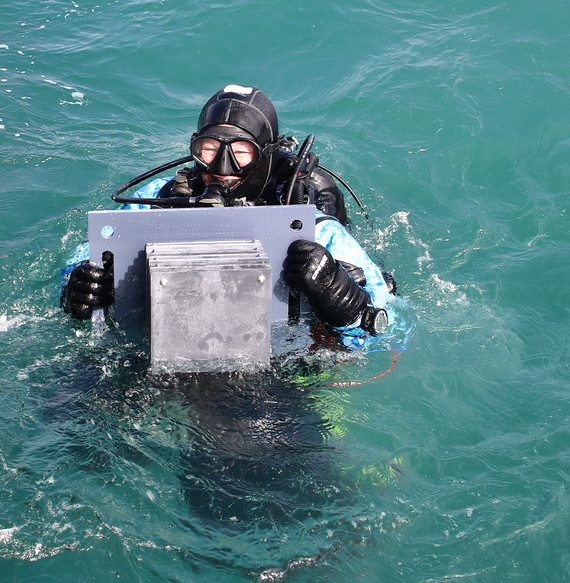When Waters Collide
A color gradient streaks the water (left side of photo) just offshore of Yachats at the end of April.
The Pacific changes color depending on its mood. Sometimes it’s clear and blue, then it changes to murky green or brown. And sometimes, there’s long colored bands in the water, like those seen the last couple of weeks between Cascade Head and Cape Perpetua Marine Reserves. A long gradient line dotted with foam separates deep blue water offshore, from cloudy green water nearshore. Welcome to a boundary zone where two ocean water masses are colliding.
High above the surface of the sea, when air masses with different temperatures collide they create weather patterns, such as a squall line. A similar thing happens in the ocean. When two water masses collide, one telltale sign on the surface is a gradient pattern and color change (click below for additional photos and to learn more).
 Dr. Cori Kane (OSU-ODFW Research Fellow) gets ready to head beneath the surface to install an ARMs unit at Otter Rock Marine Reserve.
How do you study those animals in the ocean that are often too small to see? You build them high-rise condominiums and let them live for free.
This is the approach that the ODFW Marine Reserves Program and our research partners are using to better understand biodiversity and the kinds of small or cryptic invertebrates living on nearshore rocky reefs off the Oregon Coast. This new pilot study will provide the first comprehensive data for Oregon’s nearshore ocean on the diversity of small or cryptic invertebrates. These are one of the least-known groups of organisms found on reefs in both tropical and temperate oceans worldwide.
Here's the fieldwork we've been doing over the past month:
 |
|
Hook-and-line surveys kicked off this month, and were conducted for two days at Cape Falcon Marine Reserve. |
 |
|
The ecological team deployed two oceanographic moorings at Cape Falcon and Cape Meares. |
 |
|
ARMs deployed via SCUBA divers at Otter Rock and Cape Foulweather. They will be retrieved in a couple of years. Click here to learn more about this tool. |
Updates from Collaborators
 |
|
Continuing through the spring and summer: Juvenile fish recruitment surveys (SMURFs) were deployed at Otter Rock and Cape Foulweather. This was a collaborative effort between OSU, Oregon Coast Aquarium and the ODFW Marine Reserves Program. |
Explore More Marine Reserves News
|